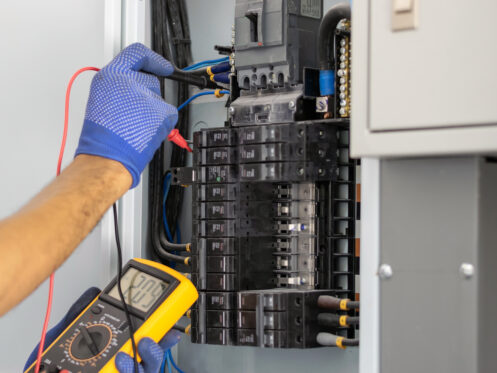The electrical panel in a home is the main hub of the electrical system. All homes have a main electrical panel either inside or outside, but it’s common for larger homes or those with specific power requirements to have one or more subpanels as well.
What Is an Electrical Subpanel?
Most homes have anywhere from a 100- to 200-amp main electrical panel. Although it’s not all that common, you occasionally see larger homes with much higher power needs that have a 400-amp electrical service and two separate 200-amp main panels. The main electrical panel in a home controls its entire electrical system and supplies power to all of the circuits. It’s also where the power from the grid connects to the home and where the main electrical shutoff is located.
An electrical subpanel is a smaller panel that only controls a few circuits and is wired directly to the building’s main panel. Subpanels are always connected to the main panel through a single 240-volt wire. There is then a double-pole 240-volt circuit breaker in the main power that can be used to shut off the power to the subpanel when needed. The subpanel itself has additional circuit breakers that control the flow of electricity to each circuit that is wired to the subpanel.
How Subpanels Reduce Electrical Installation Costs
One of the main reasons that many larger homes that were built more recently have one or more subpanels is that it keeps the cost of installing the electrical system lower when building the house. It reduces the number of “home runs” that the electricians need to install when wiring all of the circuits in the building. A home run is the wire that leads from the electrical panel to the junction box that all of the outlets, switches, and appliances on a circuit are connected to.
In a larger home, many of the circuits are located far away from the main electrical panel. Without a subpanel, the electricians will need to run a long wire from the main panel to each circuit. Wiring a home this way requires more materials and takes a long time.
By installing subpanels to power circuits far away from the main panel, the electricians can wire the house more quickly without needing nearly as many materials. In this case, all they will need to do is run one wire to the subpanel instead of having to install separate wires for each circuit. They’ll then just need to run a much shorter wire from the subpanel to the junction box for each circuit.
This same reason is why a subpanel is commonly used when putting an addition onto the home. Unless the addition is located fairly close to your main panel, installing a subpanel will be the most efficient and least expensive way to wire the addition. Similarly, you’ll often see one or more subpanels installed when partially or fully renovating a home.
Why a Subpanel Is Useful When You Need to Install Additional Circuits
Another common situation where a subpanel is used is when there’s no room to install additional circuit breakers in the home’s main panel. Let’s say that you want to install an EV charging station in your garage or a hot tub somewhere on your property. Either of these things will require you to have a new 240-volt circuit installed, which means that there needs to be two open spaces in the main panel for the double-pole breaker.
If your main panel is full, you only have a few options to accommodate the new circuit. One potential option is to combine and rewire two or more existing circuits into a single circuit. This is generally not recommended since you’ll then have a much greater chance of overloading the circuit and causing the breaker to often trip. Another option is to replace your main panel with a larger panel, which will usually add up to a few thousand dollars to the total installation cost.
There are also times when you may have the option to switch two of the existing circuits over to a tandem breaker instead of a standard single-pole breaker. A tandem breaker fits into the same size slot as a standard single-pole breaker and can control two circuits instead of just one. The main difference is that it has two smaller switches so that you can control the power to each circuit independently. One issue is that the two smaller breaker switches in a tandem breaker are half the size of a normal breaker. This means that they are more at risk of overheating and much more likely to trip when both circuits that the tandem breaker controls are under load.
Another issue with tandem breakers is that they can create a load imbalance in the main panel, which can create various electrical problems and lead to higher electricity bills. If you look at an electrical panel, you’ll see that all of the breakers are in two rows and there is close to an equal number of breakers in each row. This ensures that the load is balanced so that the electrical system works as efficiently as possible. If you install a tandem breaker, you can unbalance the load since you’ll end up with an uneven number of circuits in each row.
All of the above issues are why installing a subpanel is usually the best choice if your panel can’t support additional breakers. As long as an electrician determines that your existing main panel has enough amperage to supply the new 240-volt circuit, installing a subpanel will almost always be the easiest and cheapest option. In this case, the electrician will just need to wire one or two other circuits in the nearby area to the subpanel so that there is room to add the new double-pole breaker that controls the subpanel.
Why Subpanels Are More Convenient
Another reason that subpanels are used is simply for convenience. Let’s say that you have a workshop in your garage located on the opposite side of your house from the main electrical panel. Whenever you’re using any type of power tool, you may end up tripping the circuit breaker and shutting off the power to your garage. If you don’t have a subpanel in your garage, you’ll then need to go to the other side of your house to reset the circuit breaker at the main panel.
This is one reason why having a subpanel in the garage is much more convenient since the circuit breaker will be nearby. The added convenience is also why you commonly find subpanels installed inside or on the outside of sheds, detached garages, and other outbuildings that are powered.
Huft Home Services is the contractor you can trust for all of your home’s electrical repair, installation, and panel upgrade needs. We’ve been serving the Sacramento, Yuba City, and Elk Grove areas for the past two decades and are proud to be the top choice for electrical, plumbing, heating, and air conditioning services. Contact us today if you need to schedule a service call or if you have any questions.




